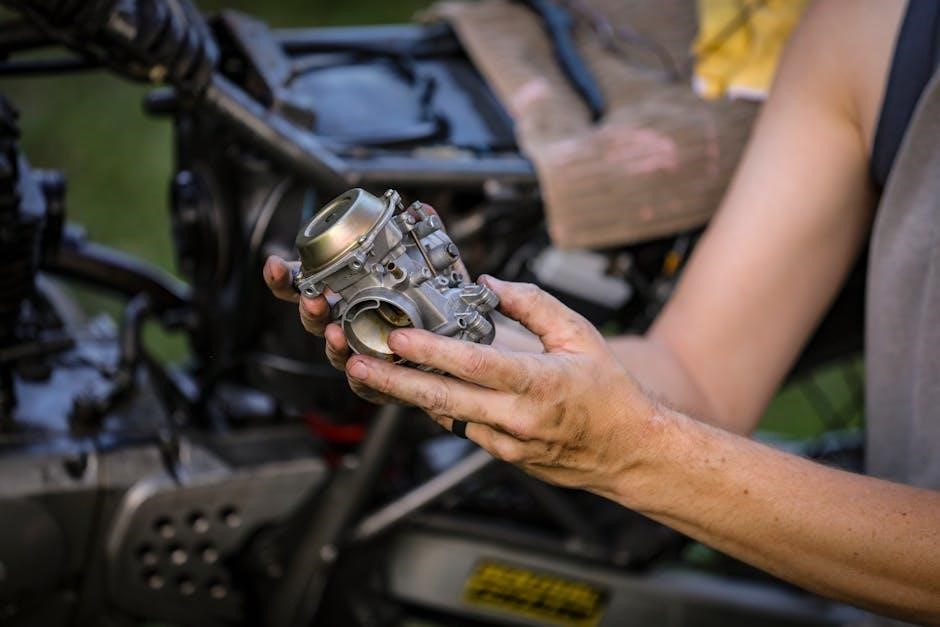
ma motorcycle manual
The MA Motorcycle Manual is a crucial guide for riders, covering licensing, safety, and road rules․ It serves as a supplement to the driver’s manual, emphasizing safe riding practices and legal requirements to ensure informed and responsible motorcycle operation in Massachusetts․
Overview of the Manual
The MA Motorcycle Manual is a comprehensive guide designed to provide motorcyclists with essential information for safe and legal riding in Massachusetts․ It covers topics such as licensing requirements, road rules, safety practices, and vehicle maintenance․ The manual serves as a supplement to the Massachusetts Driver’s Manual, offering detailed insights specifically tailored for motorcycle operation․ It is regularly updated to reflect current laws and safety standards, ensuring riders have the most accurate and relevant information․ Available online, the manual is accessible to all residents, whether they are preparing for a motorcycle license exam or seeking to refresh their knowledge․ Its clear and concise format makes it an invaluable resource for both new and experienced riders, helping them navigate Massachusetts roads confidently and responsibly․
Importance of the Manual for Riders
The MA Motorcycle Manual is a vital resource for all riders, whether they are new to motorcycling or have years of experience․ It provides critical information on safety practices, legal requirements, and best riding techniques, helping riders navigate Massachusetts roads confidently․ The manual emphasizes the importance of safety gear, road awareness, and adherence to traffic laws, which are essential for reducing accident risks․ By understanding the content, riders can ensure compliance with state regulations and adopt responsible riding habits․ It also serves as a valuable study tool for those preparing for motorcycle license exams, offering insights into the knowledge and skills needed to operate a motorcycle safely․ Regularly updated, the manual keeps riders informed about changes in laws and safety recommendations, making it an indispensable guide for motorcyclists in Massachusetts․
Structure and Contents
The MA Motorcycle Manual is organized into clear, logical sections to help riders easily access the information they need․ It begins with an introduction that outlines the purpose of the manual and its role as a supplement to the Massachusetts Driver’s Manual․ The manual is divided into key chapters, each focusing on specific topics such as licensing requirements, safety guidelines, road rules, and maintenance tips․ It also includes appendices with useful contacts, a glossary of motorcycle terms, and updates to the manual․ The content is written in a concise and easy-to-understand format, ensuring that riders can quickly find the information they need․ Whether you’re preparing for a motorcycle license exam or seeking tips for safe riding, the manual provides a comprehensive guide tailored to Massachusetts-specific regulations and best practices for motorcyclists․

Licensing Requirements
Obtaining a motorcycle license in Massachusetts involves specific requirements and processes․ The manual details these steps, ensuring riders understand the necessary criteria for legal and safe operation of motorcycles․
Eligibility Criteria for a Motorcycle License
To qualify for a motorcycle license in Massachusetts, applicants must meet specific criteria․ The minimum age for a motorcycle permit is 16, with riders under 18 requiring parental consent․ Applicants must pass a vision test and complete a motorcycle safety course approved by the RMV․ Those under 18 are also required to hold a learner’s permit for at least 6 months before applying for a full license․ Additionally, all applicants must pass a written knowledge test and a road test to demonstrate their ability to operate a motorcycle safely․ These requirements ensure that riders are prepared for the responsibilities and risks associated with motorcycling, aligning with Massachusetts’ commitment to road safety․
Application Process and Documentation
To apply for a motorcycle license in Massachusetts, visit your local RMV office with the required documentation․ You must provide proof of identity, residency, and legal presence in the U․S․ A valid Social Security number is also mandatory․ If you’re under 18, parental consent is required․ Submit a completed application form and pay the associated fees․ Vision, written, and road tests are typically required, though completing an approved motorcycle safety course may waive the road test․ Additional documentation, such as a learner’s permit or completion certificate from a safety course, may also be needed․ Ensure all paperwork is complete to avoid delays in the licensing process․
Types of Motorcycle Licenses in MA
In Massachusetts, motorcycle licenses are categorized to accommodate different rider needs and experience levels․ The primary license is the Class M, which allows operation of motorcycles․ Riders under 18 must apply for a Class M (7) license, which carries restrictions until the rider turns 18․ To obtain a Class M license, applicants must pass vision, written, and road tests or complete an approved motorcycle safety course․ Additionally, a motorcycle endorsement can be added to a valid passenger (Class D) license, enabling the holder to operate both cars and motorcycles․ Each license type ensures riders meet specific requirements to safely operate their vehicles on Massachusetts roads․
- Class M: For motorcycle operation․
- Class M (7): For riders under 18 with restrictions․
- motorcycle endorsement: Added to a Class D license for dual operation․

Safety Guidelines and Best Practices
Safety guidelines emphasize proper gear, adherence to traffic laws, and staying vigilant․ Regular bike inspections and defensive driving practices are crucial for minimizing risks and ensuring safe riding experiences․
- Always wear protective gear, including helmets and gloves․
- Follow traffic laws and maintain safe distances․
- Stay alert and anticipate potential hazards․
- Inspect your motorcycle regularly for optimal performance․
Essential Safety Gear for Riders
Essential safety gear is crucial for minimizing injury and enhancing protection while riding․ The MA Motorcycle Manual strongly emphasizes the importance of wearing proper protective equipment, including a Department of Transportation (DOT)-approved helmet, which is legally required in Massachusetts․ Additional gear includes durable gloves, long sleeves, sturdy pants, and closed-toe shoes or boots to protect against road abrasions․ Eye protection, such as goggles or a face shield, is also recommended to prevent debris from causing vision impairment․ Wearing reflective or bright clothing can increase visibility to other drivers, reducing the risk of accidents․ Regularly inspecting and maintaining this gear ensures its effectiveness․ By prioritizing safety gear, riders can significantly reduce the risks associated with motorcycle operation and enjoy a safer riding experience on Massachusetts roads․
- DOT-approved helmet for head protection․
- Gloves for grip and hand protection․
- Durable, abrasion-resistant clothing․
- Sturdy footwear and eye protection․
- Reflective gear for increased visibility․
Common Road Hazards and Safety Tips
Motorcyclists face unique challenges on the road, requiring heightened awareness and proactive safety measures․ Common hazards include potholes, gravel, wet roads, and debris, which can cause loss of control․ Additionally, sharing the road with larger vehicles demands constant vigilance, as motorcycles are less visible and more vulnerable․ To mitigate these risks, riders should maintain a safe distance, use defensive driving techniques, and stay alert for unexpected obstacles․ Avoiding distractions, such as using a phone while riding, is critical․ Riders should also be aware of their surroundings, anticipate the actions of other drivers, and adjust speed according to road conditions․ Familiarizing oneself with local traffic patterns and weather conditions can further enhance safety․ By staying informed and practicing cautious riding habits, motorcyclists can significantly reduce their exposure to potential dangers on Massachusetts roads․
- Avoid sudden maneuvers and maintain a safe following distance․
- Be cautious of road debris, potholes, and slippery surfaces․
- Use headlights and reflective gear to increase visibility․
- Stay alert for vehicles changing lanes or merging unexpectedly․
- Adjust speed according to weather and road conditions․
Group Riding Etiquette and Safety
Group riding requires coordination, communication, and mutual respect to ensure a safe and enjoyable experience for all participants․ Motorcyclists should maintain a safe distance from each other, allowing enough space to react to unexpected situations․ Riders should stay within their visibility range and avoid weaving in and out of formation․ Communication is key, often done through hand signals, to alert the group of hazards, turns, or changes in speed․ A lead rider should set a moderate pace, while a sweep rider ensures no one falls behind․ Group riding etiquette also includes staying alert, avoiding distractions, and being mindful of other road users․ Proper formation, such as staggered positioning, can improve visibility and reduce risks․ By following these guidelines, riders can enhance safety and enjoy the camaraderie of group riding on Massachusetts roads․
- Maintain a safe distance and stay in formation․
- Use hand signals to communicate hazards or changes․
- Avoid sudden movements and stay alert․
- Respect the lead rider’s pace and instructions․
- Ensure the sweep rider is aware of the group’s status;

Road Rules and Regulations
The MA Motorcycle Manual outlines specific laws for motorcyclists, including right-of-way rules, traffic signals, and speed limits․ It helps riders understand traffic violations and safe operation on Massachusetts roads․
Specific Laws for Motorcycles in MA
The MA Motorcycle Manual details laws unique to motorcyclists, such as mandatory helmet use for riders under 21 and prohibitions on lane splitting․ It also outlines passenger restrictions and equipment standards․
Motorcycles must adhere to specific regulations, including proper lighting and mirrors․ Riders are required to follow all traffic laws, with penalties for violations like reckless driving or speeding․ The manual ensures compliance with state-specific rules to enhance road safety․
Right-of-Way Rules and Signals
Understanding right-of-way rules is essential for motorcyclists in Massachusetts․ The manual emphasizes that motorcyclists must yield to pedestrians, other vehicles, and emergency responders when required by law․ Riders are encouraged to use hand signals to indicate turns, even though Massachusetts law does not mandate them․ Proper signaling helps other road users anticipate a motorcyclist’s actions, reducing the risk of accidents․
The manual also outlines the importance of adhering to traffic signals and signs․ Motorcyclists must come to a complete stop at stop signs and red lights, as failing to do so can result in severe penalties․ Riders are advised to be vigilant at intersections, where right-of-way violations are common․ By following these guidelines, motorcyclists can navigate Massachusetts roads safely and responsibly․ The manual provides clear instructions to help riders understand and respect right-of-way rules, ensuring a safer environment for all road users․
Speed Limits and Traffic Violations
Adhering to speed limits is critical for motorcyclists in Massachusetts to ensure safety and avoid legal consequences․ The MA Motorcycle Manual highlights that exceeding speed limits increases the risk of accidents and can result in fines or license suspension․ Motorcyclists must obey all posted speed limits, especially in school zones, construction areas, and residential neighborhoods, where lower speeds are mandatory․

The manual also addresses common traffic violations, such as reckless driving, failure to obey traffic signals, and improper lane changes․ Motorcyclists are reminded that they are held to the same standards as other drivers and must follow all traffic laws․ Violations can lead to increased insurance rates and penalties․ By riding responsibly and within the speed limits, motorcyclists contribute to safer roads for everyone․ The manual emphasizes the importance of compliance with traffic laws to reduce risks and ensure a safe riding experience․

Maintenance and Inspection
Regular maintenance is crucial for motorcycle safety and performance․ The manual outlines essential checks for tires, brakes, oil, and controls to ensure reliability and prevent potential issues on the road․
Regular Maintenance Checks
Regular maintenance is essential to ensure your motorcycle operates safely and efficiently․ The manual recommends checking tire pressure, oil levels, and brake functionality before every ride․ Additionally, inspect the chain or belt for proper tension and lubrication․ Ensure all lights, signals, and controls are functioning correctly․ Regularly cleaning and lubricating moving parts can prevent wear and tear․ It’s also important to follow the manufacturer’s maintenance schedule for routine services like oil changes and filter replacements․ Addressing minor issues early can prevent major repairs down the road․ By staying proactive with maintenance, riders can enhance safety, performance, and the longevity of their motorcycle․
Pre-Ride Inspection Checklist
A thorough pre-ride inspection is critical for ensuring a safe and reliable journey․ Start by checking the tire pressure and tread depth, ensuring both are within the manufacturer’s specifications․ Inspect the brakes for proper function and pad wear, and confirm that all fluid levels, including oil, coolant, and brake fluid, are at the recommended levels․ Test the headlights, taillights, turn signals, and brake lights to ensure they are functioning correctly․ Check the chain or belt for proper tension and lubrication, and inspect the suspension for any signs of damage or wear․ Also, verify that all controls, such as the throttle, brakes, and gears, are operating smoothly․ Finally, ensure the motorcycle is clean and free of debris that could obstruct visibility or performance․ This checklist helps riders identify and address potential issues before hitting the road․
DIY Maintenance Tips
Regular DIY maintenance can significantly extend the life of your motorcycle and ensure it runs smoothly․ Start by cleaning the bike thoroughly, paying attention to areas prone to rust and corrosion․ Check and lubricate the chain or belt, following the manufacturer’s recommendations for tension and lubricant type․ Inspect the air filter and replace it if dirty or damaged, as a clean filter improves engine performance and fuel efficiency․ Additionally, check the suspension for leaks or worn components and ensure all bolts and fasteners are tightened to the specified torque․ Finally, inspect the lights and signals to ensure they are functioning properly and visible to other road users․ Regularly performing these tasks not only saves money but also enhances safety and performance on the road․

Insurance Requirements
Motorcycle insurance is mandatory in Massachusetts, protecting riders against financial loss from accidents, injuries, or property damage․ Policies must meet minimum liability coverage levels to ensure adequate protection․
Types of Motorcycle Insurance
Motorcycle insurance in Massachusetts is designed to protect riders from various risks․ The primary types include liability insurance, which covers damages or injuries to others, and collision insurance, which pays for repairs to your bike after an accident․ Comprehensive insurance covers non-collision incidents like theft or vandalism, while uninsured/underinsured motorist coverage protects you if the other driver lacks sufficient insurance․ Additionally, personal injury protection (PIP) may be required to cover medical expenses for you and your passengers․ Optional coverage like roadside assistance and accessory coverage can also be added for extra protection․ Each type of insurance serves a specific purpose, ensuring riders are financially safeguarded in different scenarios․ Understanding these options helps motorcyclists choose a policy that meets their needs and complies with state requirements․
Minimum Coverage Requirements
In Massachusetts, motorcyclists must meet specific insurance requirements to legally operate their vehicles․ The minimum coverage includes liability insurance, which covers damages to others in an accident․ This is typically required at a minimum of $20,000/$40,000 for bodily injury and $5,000 for property damage․ Additionally, uninsured/underinsured motorist coverage is mandatory to protect against drivers who lack adequate insurance․ Personal injury protection (PIP) is also required, covering medical expenses for you and your passengers, regardless of fault․ These minimum requirements ensure financial protection for both riders and others involved in an accident․ Failing to meet these standards can result in penalties, fines, or even license suspension․ It is essential for motorcyclists to understand and comply with these requirements to remain legally insured and protected on the road․
Factors Affecting Insurance Rates
Several factors influence motorcycle insurance rates in Massachusetts․ The type and value of the motorcycle play a significant role, with higher-value or high-performance bikes typically costing more to insure․ Your driving record is crucial; a history of accidents or traffic violations can increase premiums․ Geographic location also matters, as urban areas with higher traffic and theft risks may lead to higher rates․ Age and riding experience are additional factors, with younger or less experienced riders often facing higher costs․ Coverage limits and add-ons, such as comprehensive or collision insurance, affect premiums․ Usage patterns, like frequent commuting versus occasional recreational use, also impact rates․ Credit score and completing a safety course can lead to discounts․ Secure storage, like a garage, might reduce theft risks and lower costs․ These elements collectively determine your motorcycle insurance rates in Massachusetts․

Rider Training and Education
Rider training and education are essential for developing safe and skilled motorcycle operators․ The MA Motorcycle Manual emphasizes the importance of completing approved safety courses to improve riding techniques and reduce risks on the road․
Available Training Courses
The Massachusetts RMV offers various training courses to help riders improve their skills and safety on the road․ These include basic rider courses designed for new motorcyclists, which cover fundamental riding techniques, traffic laws, and safety practices․ Advanced courses are also available for experienced riders to refine their abilities and learn defensive driving strategies․ Additionally, the MA Motorcycle Manual serves as a comprehensive study guide, preparing individuals for both written and road tests․ Many community colleges and motorcycle safety organizations in Massachusetts provide these courses, ensuring riders have access to quality education․ These programs are often subsidized or free, making them accessible to all․ By completing these courses, riders not only gain essential knowledge but also contribute to safer roads for everyone․
Benefits of Completing a Safety Course
Completing a motorcycle safety course offers numerous benefits for riders in Massachusetts․ These courses are designed to enhance riding skills, improve knowledge of traffic laws, and reduce the risk of accidents; Many insurance providers offer discounts to riders who complete certified safety courses, lowering premiums significantly․ Additionally, these courses often qualify for a waiver of the road test when applying for a motorcycle license․ They also foster a deeper understanding of safe riding practices, such as hazard awareness and emergency maneuvers․ By participating in a safety course, riders not only gain confidence but also contribute to creating safer roads for all users․ The combination of reduced insurance costs, improved skills, and potential license test waivers makes these courses a valuable investment for motorcyclists of all experience levels․
Tips for New Riders
New riders in Massachusetts should start with a motorcycle that fits their size and skill level, ensuring comfort and control․ Always wear protective gear, including a helmet, gloves, and sturdy footwear, to minimize injury risk․ Conduct a pre-ride inspection of the bike, checking tires, brakes, and signals․ Practice in a safe, open area before riding in traffic․ Use mirrors and signals consistently to communicate intentions to other drivers․ Stay alert and maintain a safe following distance․ Avoid riding in bad weather until gaining more experience․ Consider completing a motorcycle safety course to build confidence and skills․ Stay focused on the road and avoid distractions․ Ride defensively, anticipating the actions of other drivers․ Regular maintenance of the motorcycle is crucial for safety․ By following these tips, new riders can enhance their safety and enjoyment on Massachusetts roads․

Appendices and Resources
The manual includes appendices with useful contacts, a glossary of motorcycle terms, and information on updates․ These resources help riders stay informed and connected for safe riding in Massachusetts․
Useful Contacts and Websites
The MA Motorcycle Manual provides essential contacts and websites for riders, including the Massachusetts Registry of Motor Vehicles (RMV) for licensing and registration․ Riders can visit the RMV website at mass․gov/rmv for detailed information․ Additional resources include the Massachusetts Department of Transportation (mass․gov/eotss) and the Massachusetts Motorcycle Safety Coalition․ These websites offer safety tips, training programs, and updates on road conditions․ Riders can also find study guides and practice tests on non-government sites like dmv․org or motorcycle-test-guide․com․ These resources ensure riders have access to comprehensive support for safe and legal riding in Massachusetts․
- RMV Website: mass․gov/rmv
- Massachusetts Department of Transportation: mass․gov/eotss
- Massachusetts Motorcycle Safety Coalition: mass․gov/mmsc
Glossary of Motorcycle Terms
The MA Motorcycle Manual includes a glossary to help riders understand key motorcycle-related terms․ This section defines essential vocabulary, such as ABS (Anti-lock Braking System), which prevents wheel lock-up during braking, and countersteering, a technique for maintaining balance while turning․ Other terms like traction, referring to tire grip on the road, and engine displacement, measuring the engine’s size, are also explained․ The glossary ensures riders are familiar with critical terminology, enhancing their understanding of safe riding practices and mechanical aspects of motorcycles․ This resource is invaluable for new riders and experienced motorcyclists alike, providing clarity on industry-specific language encountered in the manual and on the road․
- ABS (Anti-lock Braking System): Prevents wheel lock-up during hard braking․
- Countersteering: Steering technique to maintain balance while turning․
- Traction: The grip of tires on the road surface․
- Engine Displacement: Measure of the engine’s size and power․
Updates and Revisions to the Manual
The MA Motorcycle Manual is regularly updated to reflect changes in laws, safety guidelines, and best practices for motorcyclists․ The Massachusetts Registry of Motor Vehicles (RMV) ensures the manual remains current, addressing new traffic laws, safety recommendations, and rider education advancements․ Riders are encouraged to check the RMV website for the latest edition annually, as updates are typically released each year․ Digital versions, including PDF downloads, are available for easy access․ Revisions often include clarifications on specific laws, updated safety tips, and new resources for rider training․ Staying informed with the most recent manual ensures riders are well-prepared to navigate Massachusetts roads safely and legally․

- Updated annually to reflect legal and safety changes․
- Available in digital formats for easy access․
- Covers new traffic laws and rider education resources․